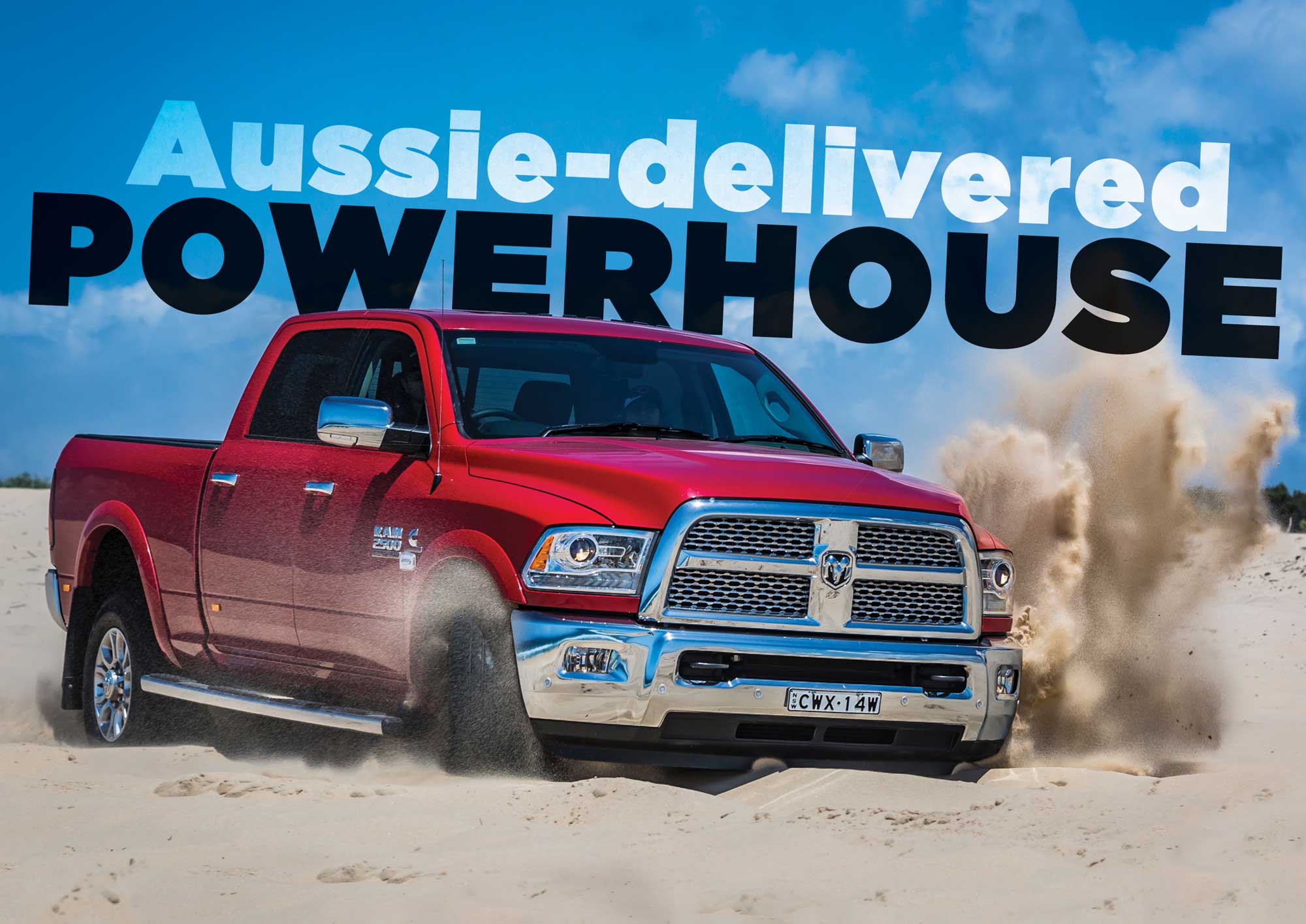The RAM is twice the price of a HiLux, is it twice as good?
There are a few things that you notice when you first get behind the wheel of a RAM. The first is, unsurprisingly, that it’s big. It’s not what I would call a 4WD in the normal sense of the term; it’s a truck (complete with an exhaust brake) with a diff at both ends and a transfer case. Although, to be fair, the size gets forgotten about after roughly half an hour behind the wheel.
The second thing that strikes you is how comfy it is… for something with solid axles that is fundamentally still a working vehicle. Leather, U-connect touch screen ICE and navigation, electric everything, an interior with more square feet than an inner city apartment and seats that actually support you while driving combine to make this just about the perfect mile-muncher.
Then there’s the looks you get when you’re driving it. Old people frown at you like you’re about to do something hooliganish, normal-sized dual-cab drivers look up in envy, Prius drivers weep for the environment (without much reason as it turns out, but I’ll get to that later), and for some reason women tend to hold up their little fingers and laugh at you when you’re fuelling up… I’m not sure what it means, but I’m pretty sure it’s a good thing.
It all disappears though when you jump back up into your cavernous, plush-pile, steering wheel equipped lounge room, pull the column shift into drive, adjust your Texan Rancher’s hat, ease your six-shooter in your holster, flex your feet in your tooled leather boots (all imaginary of course) and ease your right one down onto the ‘gas’ pedal – letting one of the nicest engines ever bolted into a 4X4 whisk you away.
For a country like ours, with huge distances in between destinations and where many of us like a lot of towing capacity and load-carrying ability, this thing could well be a dream rig. No, you wouldn’t want to take it up the shops or into many underground car parks; but for touring ability, there’s not many 4X4s that come close.
Let me explain why.
WORKING HARD
Most dual-cabs on the market these days have pretty decent payloads, GVM and GCM capacities – but if you want a vehicle that can pull up to six tonnes and have a full payload of tools or camping gear, while barely affecting power delivery, you may want to start thinking bigger. The RAM is simply built to get the job done.
It’s over-engineered too – you know, how 4X4s used to be built when nobody cared about weight or emissions regulations. Big AAM diffs at either end (11.25-in ring gear in the back, 9.25-in upfront… that’s beefy), a ladder frame chassis that could support a tank, a solid six-speed auto that complements the engine beautifully, a 180A alternator, and a tray that’s large enough to comfortably set up a swag in and sleep out of… or carry a container-load of stuff in.
And let’s talk about that engine. While the RAM has stuck with a straight-six rather than the V8s found in Ford’s and GM’s full-size offerings, it’s basically everything you could want in a 4X4 engine: 6.7L of Cummins common-rail, turbocharged diesel with 1,084Nm of torque and 276kW, it has more than enough power to do whatever the hell you want it to.
And it’s economical too. That’s right, it’s a massive engine in a massive truck with the aerodynamics of a beach ball – but it turns out that Prius driver was being overly-emotional for nothing, with the economy dipping into the 8L/100km range at the speed limit on the freeway. In fact, with a mixture of urban commuting, long stretches on the blacktop and some enthusiastic low-range work on the beach, we averaged 14.1L/100km. When you think about the dimensions of this thing, and the fact we had three people and all of their camping gear on board as well as a few other products for testing, it’s hard not to be impressed. I’ve had much worse economy from smaller rigs with less power.
SO, HOW DOES IT TOW?
In a word, brilliantly. As you’d expect, that engine just digs down and gives you so much torque that you don’t even notice hills. In fact, with all 1,084 Newtons kicking in at just 1,600rpm you could say this thing was built to pull trailers… with a tow/haul switch on the dash to deliver the torque right where it’s needed. And there’s even an integrated trailer brake controller as standard.
To make sure, we hitched up a 2.8T Goldstream Australis caravan and took it through the windy, hilly back roads of the Blue Mountains in NSW. We returned 22.6L/100km, which really isn’t bad considering the weight and the steep, twisty terrain we were on. Flat highway running saw the consumption figure drop several L/100km; and to be honest, you could be forgiven for forgetting that you were towing a 20-foot van behind you.
And it’s that sheer ease with which it does its job that made everyone here at Unsealed 4X4 fall in love with this truck. Nothing felt like a challenge. Boats, horse floats, car trailers. You’d be confident the RAM would just soak them all up and chug along happily with just about anything behind it.
I LIKE CAVIAR AND FINE CHAMPAGNE… WILL THIS ‘TRUCK’ BE UP TO MY STANDARDS?
There’s a few vehicles I’ve ridden in that I’d say are comfier than the RAM. The Range Rovers, Discoveries, 200 Series Sahara and Y62 Patrol to name a few in a similar price bracket. But this is a very different vehicle and it’s by far the comfiest solid-axle rig I’ve had the pleasure of parking my backside in for a few hours at a time. It doesn’t ride like it’s on fully-independent airbag suspension; it rides like, well, something with solid axles at either end… but there’s no shortage of interior appointments and luxury add-ons and the rough ride largely goes unnoticed. If anything, it reminds you that you’re driving a work vehicle and not a limousine – hardly a deal breaker.
The heated/vented seats feel like you’re relaxing in some sort of first-class Learjet and the centre console cleverly folds up and out of the way so you can have a bench seat if you need to carry a sixth person. As expected, rear passenger leg room is probably better than just about anything else on the market; and again, the rear seats niftily fold up – converting to a totally flat rear floor space complete with a small icebox on either side. Just the thing for throwing a mattress in the back and being able to stop for a quick overnighter without the need to set up a tent or swag.
Oh yeah, there’s also something like 17 cup holders throughout the cab.
Because ’Murica!
THIS IS A $50K TRUCK IN THE STATES WHY’S IT SO EXPENSIVE OVER HERE?
Ah, the good old Australian Tax strikes again… or does it?
At first glance, the RAM does seem a bit overpriced. I thought so too when I first picked it up. Yes, you get a lot of niceties on-board, and that engine with the ability to tow a P&O cruise ship is worth the money on its own. But why is it nearly three times the price our cousins in America pay?
There are a fair few variables wrapped up in the answer, but a lot of it comes down to the engineering involved with these things. Y’see, RAMs come into the country as complete left-hand-drive units. They’re then completely stripped back and the dash, firewall and steering are totally removed. New (fully re-designed to suit) dashes, firewalls and steering boxes are slotted in place. The quality of the work is to the point where folks from RAM in the States have come over to have a drive in the Aussie units and have remarked that they actually steer a lot better than their home-grown models. Check out the video… there is a lot of work that goes into these bad boys.
Then there’s the usual government pound of flesh and other ADR-related hoops to jump through (like the taillights that come off an Argentinian model, of all things) all of which cost time and money. It sucks, but it does beg the question…
IS IT WORTH IT?
To be honest, it’s a tricky one to answer. It’ll be a different answer for each individual asker.
For me, this vehicle represents that spot-on blend of old-school over-engineering and new-tech gadgetry to deliver something that’s part Incredible Hulk, part Iron Man. Angry and powerful if you need it to be, comfy and technologically advanced when desired.
To be fair, if you don’t need a large (or massive) 4WD and rarely tow much beyond your rear-fold camper, then you don’t need a truck – a mid-size wagon or dual-cab will fit the bill nicely for you and this may be a bit of overkill.
For my needs, and anyone who likes their comfortable, powerful, ‘workhorsey’ 4X4s that could handle any trip in Australia fresh out of the box while towing a 25-ft van… then yep, it’s worth the coin. I do a lot of remote travel, with a lot of gear, and I’m regularly towing heavy loads, so by my playbook this is about as good as it gets.
If you’re in a similar boat, the money becomes irrelevant. Nothing else will do the job like a full-size.
SPECIFICATIONS: RAM 2500 LARAMIE
Body: Available in several different configurations. Single cab, space-cab, dual-cab etc.
Engine: 6.7L Cummins straight-six turbo-diesel, 276kW @ 2,800rpm, 1,084Nm @ 1,600rpm.
Transmission: 68RFE six-speed auto, BorgWarner transfer case (2.64:1 low-range).
Brakes: Discs all ’round with twin-piston callipers and an exhaust brake (yes!).
Suspension: Radius arm and panhard front end and five-link rear, coils all ’round.
Payload: 913kg (1,713kg on the 3500).
Towing capacity: Depends on what hitch is used; up to 6,989kg with a Pintle.
GVM: 4,490kg (3,577kg kerb weight), so you can drive it on a standard car licence.
GCM (with Pintle): 11,479kg.
Warranty: 3 years/100,000km.
Price: Starting from $139,500.









